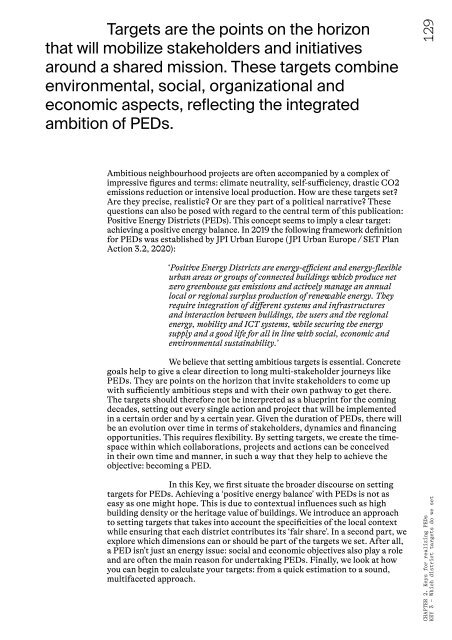Powering the energy transition at the district level_Cities4PEDs_AWB_final
Create successful ePaper yourself
Turn your PDF publications into a flip-book with our unique Google optimized e-Paper software.
Targets are <strong>the</strong> points on <strong>the</strong> horizon<br />
th<strong>at</strong> will mobilize stakeholders and initi<strong>at</strong>ives<br />
around a shared mission. These targets combine<br />
environmental, social, organiz<strong>at</strong>ional and<br />
economic aspects, reflecting <strong>the</strong> integr<strong>at</strong>ed<br />
ambition of PEDs.<br />
129<br />
Ambitious neighbourhood projects are often accompanied by a complex of<br />
impressive figures and terms: clim<strong>at</strong>e neutrality, self-sufficiency, drastic CO2<br />
emissions reduction or intensive local production. How are <strong>the</strong>se targets set?<br />
Are <strong>the</strong>y precise, realistic? Or are <strong>the</strong>y part of a political narr<strong>at</strong>ive? These<br />
questions can also be posed with regard to <strong>the</strong> central term of this public<strong>at</strong>ion:<br />
Positive Energy Districts (PEDs). This concept seems to imply a clear target:<br />
achieving a positive <strong>energy</strong> balance. In 2019 <strong>the</strong> following framework definition<br />
for PEDs was established by JPI Urban Europe (JPI Urban Europe / SET Plan<br />
Action 3.2, 2020):<br />
‘Positive Energy Districts are <strong>energy</strong>-efficient and <strong>energy</strong>-flexible<br />
urban areas or groups of connected buildings which produce net<br />
zero greenhouse gas emissions and actively manage an annual<br />
local or regional surplus production of renewable <strong>energy</strong>. They<br />
require integr<strong>at</strong>ion of different systems and infrastructures<br />
and interaction between buildings, <strong>the</strong> users and <strong>the</strong> regional<br />
<strong>energy</strong>, mobility and ICT systems, while securing <strong>the</strong> <strong>energy</strong><br />
supply and a good life for all in line with social, economic and<br />
environmental sustainability.’<br />
We believe th<strong>at</strong> setting ambitious targets is essential. Concrete<br />
goals help to give a clear direction to long multi-stakeholder journeys like<br />
PEDs. They are points on <strong>the</strong> horizon th<strong>at</strong> invite stakeholders to come up<br />
with sufficiently ambitious steps and with <strong>the</strong>ir own p<strong>at</strong>hway to get <strong>the</strong>re.<br />
The targets should <strong>the</strong>refore not be interpreted as a blueprint for <strong>the</strong> coming<br />
decades, setting out every single action and project th<strong>at</strong> will be implemented<br />
in a certain order and by a certain year. Given <strong>the</strong> dur<strong>at</strong>ion of PEDs, <strong>the</strong>re will<br />
be an evolution over time in terms of stakeholders, dynamics and financing<br />
opportunities. This requires flexibility. By setting targets, we cre<strong>at</strong>e <strong>the</strong> timespace<br />
within which collabor<strong>at</strong>ions, projects and actions can be conceived<br />
in <strong>the</strong>ir own time and manner, in such a way th<strong>at</strong> <strong>the</strong>y help to achieve <strong>the</strong><br />
objective: becoming a PED.<br />
In this Key, we first situ<strong>at</strong>e <strong>the</strong> broader discourse on setting<br />
targets for PEDs. Achieving a ‘positive <strong>energy</strong> balance’ with PEDs is not as<br />
easy as one might hope. This is due to contextual influences such as high<br />
building density or <strong>the</strong> heritage value of buildings. We introduce an approach<br />
to setting targets th<strong>at</strong> takes into account <strong>the</strong> specificities of <strong>the</strong> local context<br />
while ensuring th<strong>at</strong> each <strong>district</strong> contributes its ‘fair share’. In a second part, we<br />
explore which dimensions can or should be part of <strong>the</strong> targets we set. After all,<br />
a PED isn’t just an <strong>energy</strong> issue: social and economic objectives also play a role<br />
and are often <strong>the</strong> main reason for undertaking PEDs. Finally, we look <strong>at</strong> how<br />
you can begin to calcul<strong>at</strong>e your targets: from a quick estim<strong>at</strong>ion to a sound,<br />
multifaceted approach.<br />
CHAPTER 2. Keys for realizing PEDs<br />
KEY 3 – Which <strong>district</strong> targets do we set

















